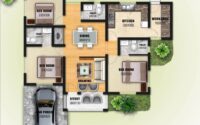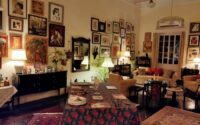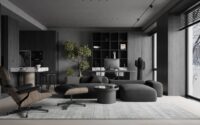1950 House Interior Design: A Time Capsule of Style
1950 house interior design embodies the optimism and innovation of the post-war era. This period saw the rise of the middle class and a surge in homeownership, leading to a unique blend of modern and traditional design elements. The 1950s aesthetic was characterized by clean lines, bold colors, and functional furniture, reflecting a shift towards a more casual and comfortable lifestyle.
Influenced by prominent designers like Eero Saarinen and Charles and Ray Eames, the 1950s interior design scene embraced a fresh approach to living spaces. From the use of vibrant color palettes and iconic furniture pieces to the incorporation of new materials and technologies, this era left an indelible mark on the world of interior design.
Historical Context
The 1950s was a period of significant change and growth in the United States, and these shifts had a profound impact on interior design trends. The post-war era brought about a surge in economic prosperity, leading to a growing middle class with disposable income and a desire for stylish, modern homes.
This desire, coupled with new technologies and materials, led to a shift away from traditional Victorian and Edwardian styles towards a more streamlined, functional aesthetic.
Architectural Styles and Their Influence on Interior Design
The dominant architectural styles of the 1950s, such as Ranch, Mid-Century Modern, and Contemporary, heavily influenced interior design trends. These styles emphasized open floor plans, large windows, and a connection to the outdoors, which translated into interiors that were bright, airy, and functional.
The use of natural materials like wood and stone, combined with clean lines and geometric shapes, created a sense of simplicity and sophistication.
- Ranch Style: This style, characterized by its low-pitched roof, single-story design, and open floor plan, often featured large windows and sliding glass doors that blurred the lines between indoor and outdoor spaces. The interiors reflected this emphasis on openness and connection to nature, incorporating natural materials like wood and stone, as well as warm, earthy color palettes.
- Mid-Century Modern: This style, known for its clean lines, geometric shapes, and use of bold colors, influenced interiors to embrace simplicity and functionality. Mid-century modern homes often featured built-in furniture, open shelving, and an emphasis on natural light. The use of materials like plywood, vinyl, and acrylic contributed to the modern aesthetic.
- Contemporary Style: This style, characterized by its emphasis on functionality and simplicity, often featured open floor plans, large windows, and a focus on natural light. The use of materials like steel, glass, and concrete created a sleek and modern aesthetic.
The Post-War Era and the Rise of the Middle Class
The post-war era saw a significant rise in the middle class, fueled by economic prosperity and the growth of suburbs. This demographic shift played a crucial role in shaping interior design trends. The middle class sought to create homes that were both stylish and affordable, leading to a demand for mass-produced furniture and home decor.
- Mass Production of Furniture: The rise of the middle class led to an increase in demand for affordable, stylish furniture. This demand was met by mass production, which allowed for the creation of furniture in a variety of styles and materials, making it accessible to a wider range of consumers.
This led to the popularity of furniture made from materials like plywood and vinyl, which were both durable and affordable.
- Suburban Living: The growth of suburbs led to a shift in home design, as families sought homes with larger yards and open spaces. This trend influenced interior design, as homes were designed to be functional and adaptable to family life. This led to the popularity of open floor plans, multi-purpose rooms, and built-in furniture.
Color Palette and Materials
The 1950s was a time of bold and vibrant colors, reflecting the optimism and prosperity of the post-war era. These colors, often paired with sleek and modern materials, defined the look and feel of 1950s homes.
Color Palette
The 1950s color palette was characterized by a combination of bright, saturated hues and softer, more muted tones. These colors were often used in bold combinations, creating a dynamic and exciting atmosphere.
- Primary Colors:Red, yellow, and blue were popular choices, often used in furniture, accessories, and even walls. These colors were seen as energetic and uplifting, reflecting the optimistic spirit of the time.
- Pastels:Soft shades of pink, blue, green, and yellow were also popular, adding a touch of femininity and sophistication to the spaces. They were often used in bedrooms, living rooms, and kitchens.
- Earthy Tones:Warm browns, tans, and greens were used to create a sense of grounding and stability. These colors were often used in dining rooms, family rooms, and outdoor spaces.
- Black and White:Black and white were used as accents, adding a touch of contrast and sophistication to the spaces. They were often used in furniture, accessories, and even walls.
Materials
The materials used in 1950s homes were both functional and stylish. They reflected the advancements in technology and manufacturing that occurred after World War II.
- Furniture Fabrics:Popular choices included velvets, brocades, and chenille. These fabrics were often used in bold colors and patterns, adding a touch of luxury and glamour to the spaces.
- Flooring:Linoleum, vinyl, and hardwood floors were common. Linoleum and vinyl were affordable and easy to maintain, while hardwood floors provided a more traditional and elegant look.
- Wall Coverings:Wallpaper, paint, and even wood paneling were popular choices. Wallpaper was often used in bold patterns and colors, adding a touch of personality to the spaces. Paint was often used in solid colors, creating a clean and modern look.
Wood paneling was used to create a warm and inviting atmosphere.
Furniture
Furniture design in the 1950s was characterized by clean lines, simple forms, and a focus on functionality.
- Mid-Century Modern:This style was characterized by its sleek lines, geometric shapes, and use of natural materials like wood and leather. Popular pieces included the Eames Lounge Chair, the Barcelona Chair, and the Saarinen Tulip Table.
- Atomic Age:This style was influenced by the space race and featured bold, futuristic designs. Popular pieces included the Sputnik Chandelier and the Mushroom Table.
Furniture and Decor
The 1950s saw a significant shift in interior design, embracing a more modern and functional aesthetic. Furniture and decor reflected this change, showcasing sleek lines, bold colors, and innovative materials.
Furniture Styles
Furniture in the 1950s was characterized by its clean lines, simple forms, and emphasis on functionality. The era witnessed a departure from the ornate and traditional styles of the past, favoring a more streamlined and modern approach.
- Mid-Century Modern: This style, which originated in the 1930s and gained popularity in the 1950s, emphasized clean lines, organic shapes, and a focus on functionality. Mid-century modern furniture often featured materials like wood, metal, and glass.
- Atomic Age: This style, influenced by the Cold War and the rise of nuclear technology, incorporated futuristic elements, bold colors, and geometric shapes. Atomic Age furniture often featured materials like plastic, vinyl, and chrome.
- Scandinavian Modern: This style, originating in Scandinavia, emphasized simplicity, functionality, and natural materials. Scandinavian modern furniture often featured light wood, neutral colors, and simple forms.
Decorative Elements
The 1950s saw the rise of bold and colorful decorative elements that added a touch of whimsy and sophistication to homes.
- Lighting Fixtures: Chandeliers with geometric shapes, pendant lights made of glass or metal, and sleek floor lamps were popular choices.
- Artwork: Abstract art, geometric patterns, and nature-inspired designs were common themes in 1950s artwork.
- Accessories: Ceramic figurines, colorful glassware, and decorative bowls were popular accessories.
Iconic Furniture Pieces and Designers
The 1950s was a golden age for furniture design, with many iconic pieces that continue to be admired today.
- Eames Lounge Chair and Ottoman (1956) by Charles and Ray Eames: This iconic chair, known for its comfort and sleek design, became a symbol of mid-century modern style.
- Barcelona Chair (1929) by Mies van der Rohe: This elegant chair, with its minimalist design and luxurious leather upholstery, was a popular choice for living rooms and offices.
- Egg Chair (1958) by Arne Jacobsen: This unique chair, resembling an egg, was designed for the Radisson Blu Royal Hotel in Copenhagen and became a symbol of Scandinavian modern style.
Living Room Design: 1950 House Interior Design
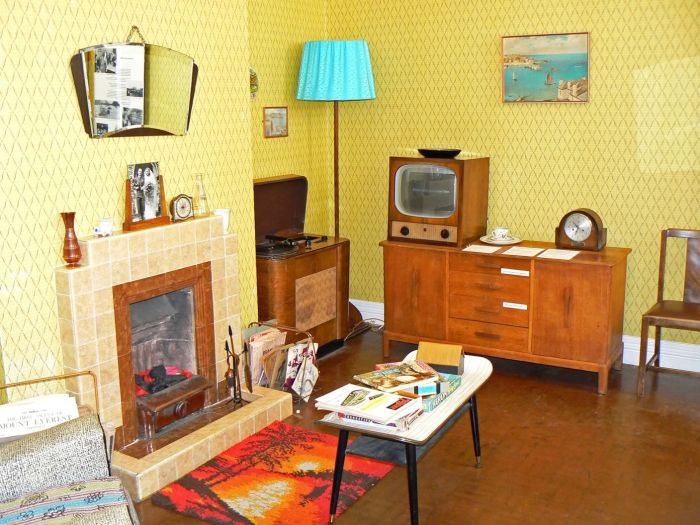
The living room, often the heart of the home, was a central space for relaxation, entertainment, and socializing in 1950s homes. Its design reflected the era’s optimistic outlook, embracing modern aesthetics and functionalism.
Living Room Layout and Features
The typical 1950s living room layout often featured a distinct focal point, typically a fireplace or a large window offering a view of the outdoors. Furniture arrangement prioritized conversation and comfortable lounging. The use of open floor plans was becoming increasingly popular, creating a sense of spaciousness and flow.
Furniture Arrangement and Decor
Furniture placement played a crucial role in creating a welcoming and functional living room. Sofas and armchairs were often grouped together to encourage conversation, while coffee tables provided a central space for drinks and snacks.
- Furniture arrangement:Sofas and armchairs were arranged in a conversational grouping, often facing a fireplace or large window. Coffee tables provided a central space for drinks and snacks, while end tables offered additional surfaces for lamps or decorative objects.
- Decor:Decorative elements, such as abstract paintings, sculptures, and plants, added pops of color and personality to the space.
1950s Living Room Layout Example
Imagine a living room with a large picture window overlooking a lush garden. A plush, oversized sofa sits facing the window, inviting relaxation and contemplation. Two armchairs flank a coffee table, positioned for intimate conversations. A side table holds a stylish lamp, casting a warm glow on the space.
1950s house interior design often featured sleek lines and a focus on functionality, often incorporating bold colors and geometric patterns. While a full-scale 1950s renovation might be ambitious, you can still capture the essence of this era in a smaller space by exploring 1 bedroom house interior design ideas.
For instance, incorporating mid-century modern furniture, like a classic Eames chair or a sleek credenza, can add a touch of 1950s charm to a contemporary space.
A low-profile television set sits on a sleek console, offering entertainment options. The room’s walls are adorned with abstract artwork, adding a touch of modern sophistication. A large rug anchors the furniture arrangement, adding warmth and visual interest.
The overall effect is one of comfortable elegance, reflecting the optimism and sophistication of the 1950s era.
Kitchen Design
The 1950s saw a significant shift in kitchen design, moving away from the utilitarian spaces of the past and embracing a more modern and functional approach. The focus was on creating efficient and stylish kitchens that were both practical and aesthetically pleasing.
Appliances and Features
The rise of the modern kitchen was largely driven by the introduction of new appliances and features. These advancements transformed the way people cooked, cleaned, and interacted with their kitchens. Here are some notable examples:
- Refrigerators:The 1950s saw the widespread adoption of refrigerators, becoming a staple in most kitchens. These appliances were often larger and featured modern designs, often with rounded edges and colorful finishes. Some even came equipped with automatic ice makers.
- Electric Ranges:Electric ranges replaced gas stoves in many homes, offering convenience and safety. These ranges featured multiple burner configurations and ovens with temperature controls.
- Dishwashers:While still a relatively new invention, dishwashers began to gain popularity in the 1950s. These appliances offered a significant time-saving advantage, making the chore of washing dishes much easier.
- Garbage disposals:These innovative devices were integrated into kitchen sinks, offering a convenient way to dispose of food scraps and reduce odors.
Functionality and Efficiency
The design principles of the 1950s kitchen prioritized functionality and efficiency. The goal was to create a space where cooking and cleaning were streamlined and enjoyable. Here are some key elements:
- Work triangle:The work triangle concept, which emphasizes the efficient placement of the sink, stove, and refrigerator, was popularized in the 1950s. This layout ensured a smooth workflow for preparing meals and cleaning up.
- Built-in appliances:Built-in appliances, such as ovens, refrigerators, and dishwashers, became increasingly common. This approach maximized space and created a more integrated look.
- Storage solutions:Clever storage solutions were essential for keeping kitchens organized. Cabinets, drawers, and shelves were designed to maximize storage space and keep frequently used items within easy reach.
Design Trends, 1950 house interior design
The 1950s saw the emergence of several kitchen design trends that reflected the era’s style and values:
- Open-plan layouts:The concept of open-plan kitchens, where the kitchen seamlessly connects to the dining or living areas, gained traction in the 1950s. This trend created a more social and inviting atmosphere.
- Color palettes:Pastel colors were widely used in 1950s kitchens, creating a cheerful and airy ambiance. Popular choices included shades of pink, blue, yellow, and green.
- Materials:Formica countertops were a popular choice for their durability and ease of maintenance. Other materials used included stainless steel, chrome, and laminated wood.
- Mid-century modern style:The mid-century modern design aesthetic, with its clean lines, simple forms, and use of natural materials, influenced kitchen design. This style brought a sense of sophistication and functionality to the space.
Bedroom Design
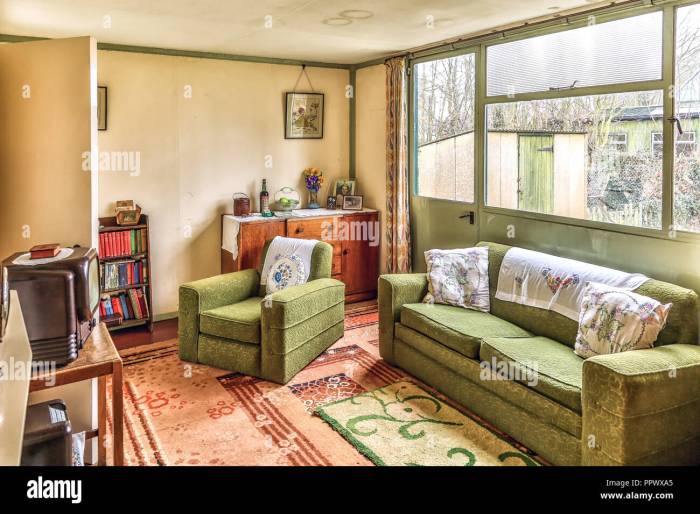
The 1950s bedroom was a sanctuary of comfort and privacy, reflecting the values of the era. It was a space designed for relaxation and rejuvenation, away from the hustle and bustle of daily life.
Bedroom Layout and Features
The typical 1950s bedroom featured a double bed, often with a headboard and footboard, a dresser, a nightstand, and a chair. The bed was usually placed against a wall, with the dresser and nightstand on either side. The chair could be used for reading or simply relaxing.
- Bedding:The bed was typically dressed in simple, yet elegant, bedding. Sheets and pillowcases were often made of cotton or linen, with floral patterns or solid colors. Quilts and blankets were popular, adding warmth and texture to the bedroom.
- Decor:The bedroom was often decorated with personal touches, such as family photos, artwork, and plants. Some bedrooms also featured a vanity or dressing table for applying makeup or fixing hair.
- Color Palette:The color palette of a 1950s bedroom was often inspired by nature. Popular colors included pastels, such as pale pink, blue, and green, as well as earth tones, such as beige and brown. These colors created a calming and inviting atmosphere.
Comfort and Privacy
Comfort and privacy were paramount in 1950s bedroom design. The bedroom was seen as a personal retreat, a place where people could escape from the stresses of everyday life.
- Soft Furnishings:Soft furnishings, such as rugs, curtains, and throw pillows, added to the sense of comfort and coziness.
- Privacy:The bedroom was typically located away from the main living areas of the house, providing a sense of privacy and seclusion.
1950s Bedroom Design Trends
The 1950s saw a number of popular bedroom design trends, reflecting the era’s fascination with modernism and the atomic age.
- Bold Colors:The use of bold colors, such as turquoise, lime green, and coral, was a popular trend in 1950s bedroom design. These colors added a sense of energy and excitement to the space.
- Geometric Patterns:Geometric patterns, such as stripes, polka dots, and checkerboards, were also popular in 1950s bedroom decor. These patterns added a sense of modernity and sophistication.
- Atomic Age Influences:The atomic age had a significant impact on 1950s design, and this influence was also seen in bedroom decor. For example, some bedrooms featured furniture and accessories with atomic-inspired shapes and motifs.
Modern Influences
The 1950s saw a significant shift in interior design, with the emergence of mid-century modern style. This new aesthetic, characterized by clean lines, functional furniture, and a focus on natural materials, was a direct response to the traditional, ornate styles that dominated the previous decades.
The Impact of Mid-Century Modern Design
The mid-century modern movement, which gained momentum in the 1950s, significantly impacted interior design. This style emphasized functionality, simplicity, and a connection to nature. It sought to create spaces that were both aesthetically pleasing and comfortable for everyday living.
“Mid-century modern design is a style that emphasizes functionality, simplicity, and a connection to nature.”
The Use of Natural Materials
Natural materials like wood, leather, and stone were prevalent in 1950s homes. These materials brought a sense of warmth and authenticity to the spaces, contrasting with the cold, sterile look of many contemporary homes.
“Wood, leather, and stone were common materials used in mid-century modern homes.”
Clean Lines and Functional Furniture
The emphasis on functionality extended to furniture design. Mid-century modern furniture featured clean lines, simple forms, and a focus on comfort. Iconic pieces like the Eames Lounge Chair and the Barcelona Chair became symbols of the era.
1950s house interiors often featured a mix of modern and traditional elements, with clean lines and a focus on functionality. While the square footage of a home doesn’t dictate its style, 1100 sq ft house interior design can still embrace the spirit of the era.
For example, using bold colors and geometric patterns on furniture and upholstery can evoke the vibrant energy of the 1950s.
“The Eames Lounge Chair and the Barcelona Chair are iconic examples of mid-century modern furniture.”
Modern Design Principles in Various Rooms
Mid-century modern principles were incorporated into various rooms of a 1950s home:
- Living Room:Open floor plans, large windows to let in natural light, and modular furniture were common features.
- Kitchen:The kitchen was no longer a separate, enclosed space. It became an integrated part of the home, with open shelving, sleek countertops, and appliances designed for both functionality and aesthetics.
- Bedroom:Mid-century modern bedrooms featured simple, streamlined furniture, neutral color palettes, and natural materials.
Examples and Inspiration
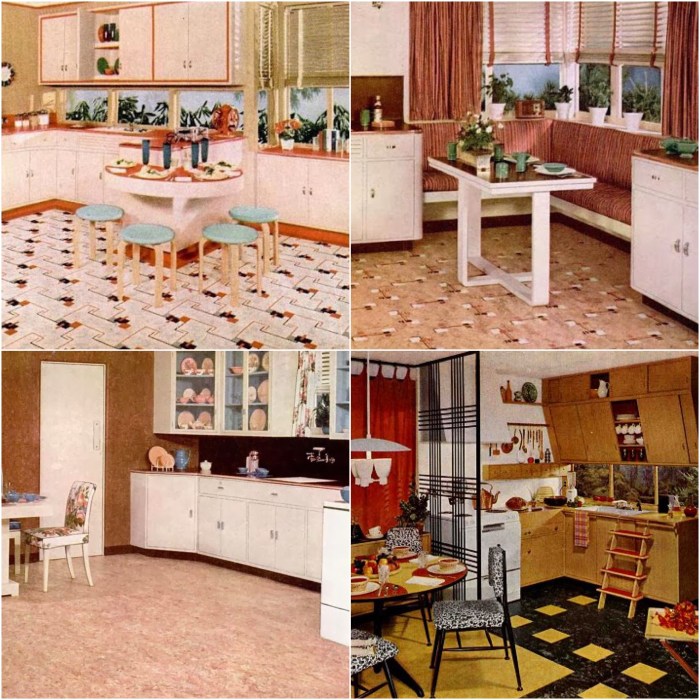
To truly understand the charm and style of 1950s interior design, it’s helpful to see it in action. This section explores some iconic homes and design elements that embody the era’s aesthetic.
1950s house interiors often featured bold colors, geometric patterns, and a focus on functionality. While those design elements might seem dated today, they can still inspire modern homeowners. For instance, the concept of maximizing space, a key aspect of 1950s design, is also crucial in 1 bhk house interior design.
By incorporating clever storage solutions and multi-functional furniture, you can create a stylish and efficient space, just like those iconic 1950s homes.
Examples of 1950s Homes
Many homes built in the 1950s still stand today, offering a glimpse into the past. Here are a few examples:
| Home | Location | Key Design Features | Image |
|---|---|---|---|
| Eichler Home | California, USA | Open floor plans, large windows, exposed beams, use of natural materials | An Eichler home, with its signature open floor plan, large windows, and use of natural materials, showcasing a living room with a fireplace and mid-century furniture. The walls are painted in a light neutral color, and the floors are covered in a warm wood laminate. The overall aesthetic is one of simplicity and functionality, with a focus on creating a connection between the indoors and outdoors. |
| Levitt Home | Suburban areas across the USA | Affordable, mass-produced homes with standardized designs, often featuring a gable roof, brick exterior, and a traditional layout | A Levitt home, featuring a gable roof, brick exterior, and a traditional layout. The interior is characterized by its functional design, with a focus on maximizing space and providing a comfortable and practical living environment. The color palette is typically neutral, with accents of color added through furniture and decor. |
| Mid-Century Modern Ranch | Across the USA | Low-slung, single-story homes with open floor plans, large windows, and a focus on indoor-outdoor living | A mid-century modern ranch home, with its low-slung profile, open floor plan, and large windows. The interior is characterized by its use of natural materials, such as wood and stone, and a minimalist aesthetic. The furniture is typically sleek and functional, with a focus on comfort and practicality. The color palette is often neutral, with pops of color added through accent pieces and artwork. |
Final Review
Stepping into a 1950s home is like stepping back in time, where modern functionality meets classic charm. The era’s focus on practicality and comfort, combined with its bold use of color and form, continues to inspire contemporary design trends. Whether you’re seeking inspiration for a retro-inspired renovation or simply curious about the evolution of interior design, exploring the world of 1950s homes offers a fascinating glimpse into the past and a timeless source of design ideas.
FAQ Resource
What are some popular 1950s furniture styles?
Popular styles include Mid-Century Modern, Scandinavian Modern, and Atomic Age design, characterized by sleek lines, organic shapes, and the use of materials like teak and chrome.
How can I incorporate 1950s elements into my modern home?
You can incorporate elements like iconic furniture pieces, vintage lighting, geometric patterns, and bold color accents. Consider using a neutral backdrop and adding pops of color with textiles, artwork, or accessories.
Where can I find inspiration for 1950s interior design?
Online resources like Pinterest, Houzz, and design blogs are great places to find inspiration. You can also visit vintage furniture stores, antique shops, and museums to see examples of authentic 1950s interiors.

